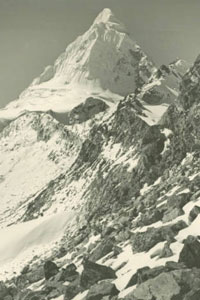1949-1950 Sikkim Expedition Video
This film record relates to the first expedition to Sikkim undertaken by my father. His travelling companion was Trevor Braham, who also led the expedition. Trevor Braham was an early member of the Himalayan Club and later became the editor of The Himalayan Journal in the late 1950s. This expedition was fortunate in obtaining the services of the noted sherpa, Ang Tharkay, who helped put together a fine team of sherpas in Gangtok, Sikkim. My father also brought along a pair of skis. The expedition started out from Gangtok in November, 1949; they trekked to Sebozung via Mome Samdong, Lachung and Yumtang. My father was unfortunately affected by altitude sickness early in the trek but the prospect of skiing kept him going. He finally got his opportunity to ski on the Khangkyong plateau and glacier region.
Here is an extract from Himalayan Odyssey (1974) by Trevor Braham (page 56) “From the pass the slopes fell away gently to the west, assuring us of a straight forward descent and enabling Hruska at last to put on his skis. As he glided smoothly, noiselessly down the long slopes, the sherpa’s reaction was first one of amusement then of envy. There were superb views to the south-west of Chombu and Kangchenjunga”. My father eventually curtailed the expedition and returned to Gangtok because of his altitude sickness.

View of Mt. Chombu from Sebu La Pass
While the use of skis was unusual, he was not the first to ski on elevated plateaus and Himalayan glaciers. As early as the 1920s, probably earlier, there existed a Ski Club of India in Gulmarg, Kashmir. Later during the British ascent of Kamet 7755m in 1931, one of the expedition members used skis from a col at 7162m. Kamet is the second highest mountain in the Garwhal region, 250 kms northeast of the city of Delhi just west of the point where Tibet, Nepal and India meet, namely at the western end of the Himalayas. My father’s 1949/1950 expedition probably marked one of the first attempts to ski in the eastern Himalayan range.
This 1949/1950 expeditions, including the 1952 and 1954 expeditions, were in many ways unique, not from any peaks scaled, but from what they achieved. In 1949/1950, 1952 and 1954, various parts of Northern Sikkim and the Nepal Kangchenjunga region were not well known. The maps of the day contained huge gaps captioned with the words “Uncharted area,” or with “graphical clouds” labelled “Number of peaks uncertain”. My father later recounted often to us that his films and photographs helped complete knowledge of the region for cartographers.
The film record of the 1949/1950 expedition was made with a 16mm Paillard Bolex movie camera. This film record is quite extraordinary when it is noted that it was exceedingly difficult to obtain 16mm colour film in Calcutta, India in 1949. Time unfortunately has also taken its toll on the quality of the film record but the film is still a statement of the curiosity and the adventurous spirit of the early climbers and trekkers of the period.
